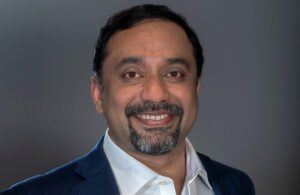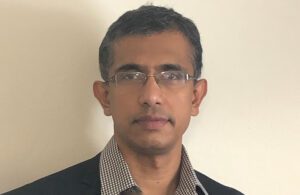
GE Healthcare Life Care Solutions Chief Technology Officer Roshy Francis [Photo courtesy of GE Healthcare]
Set to spin off from parent company GE (NYSE:GE) next year, GE Healthcare leverages artificial intelligence (AI) to help providers improve efficiency, patient outcomes and access to care with its AI-based imaging applications and Edison Health Services platform.
As part of the Medical Design & Outsourcing cloud conversation series with medtech innovators and leaders, three leaders from GE Healthcare — Life Care Solutions Chief Technology Officer Roshy Francis, SVP and Imaging Solutions GM Rekha Ranganathan and VP and Edison AI and Platform GM Vignesh Shetty — offered their vision for the cloud-enabled future of healthcare.
This conversation has been edited for space and clarity.
MDO: What are some surprising and inspirational examples of what cloud computing enables with regard to medical device design, manufacturing and capabilities/performance?
RANGANATHAN: With the recent technological advances in cloud connectivity and remote operations becoming more accepted by physicians and providers, the vision of collaborating across the globe and bringing care to patients has become a reality. For example, cloud enablement is now offering the ability to view images and collaborate remotely from anywhere. They can also train technologists and control scans remotely and efficiently. More experienced technologists can also access imaging systems and work with more junior technologists remotely to increase the level of care to patients, driving the right protocol management and expedite processes. In addition, cloud-based protocol management lets us disseminate good practices to sites regionally or globally. This allows us to get the best images for our patients and have optimized, patient-specific care. It has helped significantly reduce the need for hospital networks to perform manual device updates, reducing costs, time, and labor. The solution can scale on demand to serve small practices and large, multi-facility networks and across their fleet of systems.
FRANCIS: The pandemic has overwhelmed hospital systems around the world. The patient complexity has increased with multiple comorbidities. These dynamics require multi-specialty care teams to collaborate to make timely and accurate decisions in acute care settings. Clinical care teams can now virtually come together around a patient, with a complete picture of the patient from various systems, without having to be physically present at the bedside. We have deployed solutions on the cloud that help ensure care protocol compliance in the ICU and Labor & Delivery, for timely interventions that lead to improved patient outcomes. We are now deploying solutions that allow complex procedures like anesthesia delivery to be monitored and guided by experienced anesthesiologists remotely.
SHETTY: During the pandemic there was a ramp-up in demand for home-reporting and virtual consultation solutions, with many radiologists and diagnostic staff working from home. This had a positive effect on cloud adoption. Such are the access and elasticity benefits offered by cloud solutions versus on-premise for remote and distributed care networks.

GE Healthcare VP and Edison AI and Platform GM Vignesh Shetty [Photo courtesy of GE Healthcare]
MDO: What are some previously unthinkable advances that now seem increasingly likely to become reality?
RANGANATHAN: Previously, doing remote intervention or providing a platform for the care team to collaborate across oceans only happened in sci-fi novels and movies. But the advent of 5G technologies and cloud networks, transmitting complex content in milliseconds is a reality. Interventionalists can collaborate with each other with videos streaming real-time from cath labs or operating theaters, especially for complex procedures to bring the best patient care possible. With healthcare organizations moving toward value-based care models, collaboration is essential between doctors, departments, and even institutions. Medical providers can transfer data between each other through a cloud computing server, boosting cooperation, discussing dashboards and treatment options for increasing patient care and making it more personalized for better treatment. Knowing the treatment pathway, patient outcomes, and providers involved makes it easier to enable true risk-sharing models which before were not possible.
FRANCIS: Through aggregation of data across many disparate systems, we will soon be able to build a comprehensive, longitudinal view of a patient from hospital to home. Some of the big data technologies in the cloud are accelerating research that generate insights using machine learning that were previously not possible. Being able to monitor the patient’s condition across the care continuum will also allow moving patients from acute settings to general wards and to home with confidence, reducing costs without sacrificing quality.
SHETTY: For many physicians, the main hurdle to AI adoption is really getting experience with the technology while minimizing risk and distraction. Many are afraid to try without knowing that it’s not going to interfere with their clinical routine. It’s a quandary that can only be resolved with thoughtful, targeted AI based on longitudinal patient data that builds trust. Trust leads to utilization, which will unleash AI’s true potential. When it comes to deployment, an important hurdle is how to ensure safety and efficacy over time as AI algorithms on device and edge adapt and evolve, through the continual evaluation of performance and assessing the need for reapprovals of specific AI solutions. This becomes significantly more frictionless on the cloud.
MDO: And finally, what sort of big, futuristic dreams do these or other advancements inspire?
RANGANATHAN: With cloud computing, distributed networks and 5G connectivity, we can truly bring quality care to the patient, regardless of location. That means in the hospital, in their home or in the field. We can also achieve faster diagnoses with access to the best physicians for patients who are in remote locations or rural areas. This will greatly improve access to care regardless of socioeconomic or geographic challenges and enable physicians to also deliver more personalized care and be more precise with outcomes.
FRANCIS: We believe that hybrid cloud computing, together with advances in 5G and artificial intelligence, will accelerate digitization of healthcare worldwide. In the past, digitization meant replacing an older, paper-based workflow in a department with an electronic equivalent limiting the impact of digitization on patient outcomes. Today, advanced enterprise-wide solutions that allow clinicians to visualize the patient throughout the continuum of care remotely are already being deployed at scale. In the future, access to big data that are being aggregated by these solutions, combined with easily accessible AI development technologies, will drive creation of novel applications that deliver predictive insights that will enable timely interventions by clinicians, dramatically improving outcomes.
SHETTY: Over and above anything else, we must prove that AI works — and provide a prescription for hospitals to lead their own AI adoption. For them, putting AI into the workflow and growing utilization is of primary importance. For years we have been talking about the possibilities of AI in healthcare, often with the assumption that breakthroughs will come from big tech. We increasingly believe that the major innovators are small- to medium-sized companies with deep domain expertise working closest to the action at the clinical level that partner with the incumbents who have years of expertise and relationships in this domain. This is what is possible with a cloud-based AI ecosystem enabled by a platform.
Read more from our conversations with leaders at companies such as Johnson & Johnson, Microsoft, Philips, Google and Delta Development.